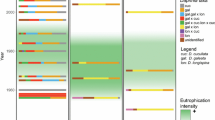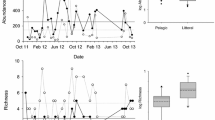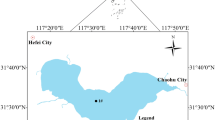Abstract
We studied the egg banks of Daphnia gr. longispina in four acidified lakes in the Bohemian Forest (Czech Republic, Europe). Daphnia had become extinct in three of the studied lakes due to anthropogenic acidification and we assessed the possibility of autochthonous recovery of the population after recent amelioration of the lake environment. We determined the ephippia distribution in eleven cores 10–30 cm long, and the state of Daphnia resting eggs in over 13 000 ephippia from eight cores. Apparently well-preserved eggs were used for hatching experiments and for DNA amplification. Vertical profiles of ephippia densities in several cores did not agree with historical data on the Daphnia presence in the lakes, as the sediment had been repeatedly disturbed by human activities in the past. Ephippia are present near the surface of the sediment in all lakes, and they might therefore receive hatching cues. We were not able, however, to prove that viable eggs are present in the ephippia banks of the lakes. The percentage of the well-preserved eggs in all but one core was below 1%. In addition, no egg hatched in the hatching experiments and we were not able to amplify DNA from the preserved eggs of lakes where Daphnia is extinct, although amplification from relatively young eggs from the fourth lake was successful in 60% of the cases. We conclude that the recovery of Daphnia populations in studied lakes from autochthonous sources is unlikely.
Similar content being viewed by others
References
Caáres, C. E., 1997. Temporal variation, dormancy and coexistence: a field test of the storage effect. Ecology 99: 9171-9175.
Caáres, C. E., 1998. Interspecifc variation in the abundance, production and emergence of Daphnia diapausing eggs. Ecology 79: 1699-1710.
Cousyn C., L. De Meester, J. K. Colbourne, L. Brendonck, D. Verschuren & F. Volckaert, 2001. Rapid, local adaptation of zooplankton behavior to changes in predation pressure in the absence of neutral genetic changes. Evolution 98: 6256-6260.
De Meester, L., A. Gómez, B. Okamura & K. Schwenk 2002: The Monopolisation Hypothesis and the dispersal — gene flow paradox in aquatic organisms. Acta Oecologica 23: 121-135.
Duffy, M. A., L. J. Perry, C. M. Kearns, L. J. Weider & N. G. Hairston, Jr., 2000. Paleogenetic evidence for past invasion of Onondaga Lake, New York, by exotic Daphnia curvirostris using mtDNA from dormant eggs. Limnology and Oceanography 45: 1409-1414.
Fott, J., M. Pražáková, E. Stuchlík & Z. Stuchlíková, 1994. Acidification of lakes in Šumava (Bohemia)and in the High Tatra Mountains (Slovakia). Hydrobiologia 274: 37-47.
Frey, D., 1987. Taxonomy and biogeography of the cladocera. Hydrobiologia 145: 5-17.
Frič, A., 1872. Über die Fauna der Böhmerwaldseen. Sitzungsberichte der königlichen böhmischen Gesellschaft der Wissenschaften Prag 1: 3-12.
Frič, A., 1873. Über weitere Untersuchungen der Böhmerwaldseen. Sitzungsberichte der königlichen böhmischen Gesellschaft der Wissenschaften Prag 3: 103-109.
Fryer, G., 1996. Diapause, a potent force in the evolution of freshwater crustaceans. Hydrobiologia 320: 1-14.
Gilbert, J. J., 1974. Dormancy in rotifers. Transactions of the American Microscopical Society 93: 490-513.
Hairston, N. G., Jr., 1996. Zooplankton egg banks as biotic reservoirs in changing environments. Limnology and Oceanography 41: 1087-1092.
Hairston, N. G., Jr. & C. E. Caáres, 1996. Distribution of crustacean diapause: micro-and macroevolutionary pattern and process. Hydrobiologia 320: 27-39.
Hairston, N. G., Jr., R. A. Van Brunt, C. M. Kearns & D. R. Engstrom, 1995. Age and survivorship of diapausing eggs in a sediment egg bank. Ecology 76: 1706-1711.
Hairston, N. G. Jr., L. J. Perry, A. J. Bohanak, M. Q. Fellows & C. M. Kearns, 1999. Population biology of failed invasion: paleolimnology of Daphnia exilis in upstate New York. Limnology and Oceanography 44: 477-486.
Jeppesen, E., P. Leavitt, L. De Meester & J. P. Jensen, 2001. Functional ecology and palaeolimnology: using cladoceran remains to reconstruct anthropogenic impact. Trends in Ecology and Evolution 16: 191-198.
Kearns, C. M., N. G. Hairston, Jr. & D. H. Kesler, 1996. Particle transport by benthic invertebrates: its role in egg bank dynamics. Hydrobiologia 332: 63-70.
Kerfoot, W. C., J. A. Robbins & L. J. Weider, 1999. A new approach to historical reconstruction: combining descriptive and experimental paleolimnology. Limnology and Oceanography 44: 1232-1247.
Kohout, L., 2001. Zooplankton Šumavských jezer. MSc. thesis. Charles University, Prague, 156 pp [in Czech].
Kopaák, J., J. Hejzlar, E. Stuchlík, J. Fott & J. Veselý, 1998a. Reversibility of acidification of mountain lakes after reduction in nitrogen and sulphur emissions in Central Europe. Limnology and Oceanography 43: 357-361.
Kopaák, J., J. Veselý & J. Hejzlar, 1998b. Bedrock and soil compositions: crucial factors governing phosphorus input and trophic status of forest lakes in Bohemian Forest. Acta Universitatis Carolinae, Geologica 42: 55-59.
Kopaák, J., E. Stuchlík, J. Veselý, J. Schaumburg, I. C. Anderson, J. Fott, J. Hejzlar & J. Vrba, 2002. Hysteresis in reversal of central European mountain lakes from atmospheric acidification. Water, Air, and Soil Pollution: Focus 2: 91-114.
Krantzberg, G., 1985. The influence of bioturbation on physical, chemical and biological parameters in aquatic environments: a review. Environmental Pollution, Series A: Ecological and Biological 39: 99-122.
Limburg, P. A. & L. J. Weider, 2002. “Ancient ” DNA in the resting egg bank of a microcrustacean can serve as a paleolimnological database. Proceedings of the Royal Society of London, Series B: Biological Sciences 269: 281-287.
Marcus, N. H., R. Lutz, W. Burnett & P. Cable, 1994. Age, viability and vertical distribution of zooplankton resting eggs from an anoxic basin: evidence of an egg bank. Limnology and Oceanography 39: 154-158.
Moritz, C., 1987. A note on the hatching and viability of Ceriodaphnia ephippia collected from lake sediment. Hydrobiologia 145: 309-314.
Moritz, C., 1988. Die Verteilung der Ephippien von Bosmina longirostris und Ceriodaphnia pulchella im Sediment des Piburges Sees (ötztal, Tirol) (Cladocera, Crustacea). Berichte des Naturwissenschaftlich-Medizinischen Vereins in Innsbruck 75: 91-107.
Petrusek, A., M. Faustová & M. Cerný, 2003. Daphnia resting eggs in the sediment of Bohemian Forest lakes: an evidence for sediment disturbance. Silva Gabreta 9: 71-80.
Peters, R. H., 1987. Daphnia culture. In Peters, R. H. & R. De Bernardi (eds), Daphnia. Memorie dell 'Istituto Italiano di Idrobiologia 45: 483-495.
Prazáková, M. & J. Fott, 1994. Zooplankton decline in the Cerné Lake (Šumava Mountains, Bohemia) as reflected in the stratification of cladoceran remains in the sediment. Hydrobiologia 274: 121-126.
Procházková, L. & P. Bla zka, 1999. Chemismus a oživení Šumavských jezer na počátku 60-tých let. Silva Gabreta 3: 65-72. [in Czech].
Reid, V. A., G. R. Carvalho & D. G. George, 2000. Molecular genetic analysis of Daphnia in the England Lake District: species identity, hybridization and resting egg banks. Freshwater Biology 44: 247-253.
Schmidt, R., K. Arzet, E. Facher, J. Fott, K. Irlweck, Z. řeháková, N. Rose, V. StraŠkrabová & J. Veselý, 1993: Acidification of Bohemian lakes. Recent trends and historical development. Ost-West Programm, Mondsee, 86 pp.
Schwartz, S. S. & P. D. N. Hebert, 1987. Methods for the activation of the resting eggs of Daphnia. Freshwater Biology 17: 373-379.
Schwenk, K., D. Posada & P. D. N. Hebert, 2000. Molecular systematics of European Hyalodaphnia: the role of contemporary hybridization in ancient species. Philosophical Transactions of the Royal Society of London, Series B: Biological Sciences 267: 1833-1842.
Šrámek-HuŠek, R., 1942. Revise perlooček a buchanek Černého jezera na Šumavěpo 66 letech. Věstník Královskéčeské společnosti nauk, Praha, třida II: 1-22 [in Czech].
Stross, R. G., 1966. Light and temperature requirements for diapause development and release in Daphnia. Ecology 47: 368-374.
Veselý, J., 1994. Investigation of the nature of the Šumava lakes: a review. Casopis Národního muzea, řada přírodovědná 163: 103-120 [with update in Czech: pp. 11-21].
Veselý, J., 1996. Změny slození vod Šumavských jezer v letech 1984 až 1995. Silva Gabreta 1: 129-141 [in Czech].
Vrba, J., J. Kopaák & J. Fott, 2000. Long-term limnological research of the Bohemian forest lakes and their recent status. Silva Gabreta 4: 7-28.
Vrba, J., J. Kopaák, V. StraŠkrabová, J. Hejzlar & K. Šimek, 1996. Limnological research of acidi ed lakes in Czech part of the Šumava mountains: trophic status and dominance of microbial food webs. Silva Gabreta 1: 151-164.
Vrba, J., J. Kopaák, J. Fott, L. Kohout, L. Nedbalová, M. Pra záková, T. Soldán & J. Schaumburg, 2003. Long-term studies (1871–2000) on acidification and recovery of lakes in the Bohemian Forest (Central Europe). Science of the Total Environment 310: 73-85.
Weider, L. J., W. Lampert, M. Wessels, J. K. Coulborne & P. Limburg, 1997. Long-term genetic shift in a micro crustacean egg bank associated with anthropogenic changes in the Lake constance ecosystem. Proceedings of the Royal Society of London, Series B: Biological Sciences 264: 1613-1618.
Wood, T. R. & A. M. Banta, 1933. Observations on procuring and hatching sexual eggs of Daphnia longispina. Internationale Revue der gesamten Hydrobiologie und Hydrographie 29: 437-454.
Author information
Authors and Affiliations
Rights and permissions
About this article
Cite this article
Faustová, M., Petrusek, A. & Černý, M. Status of Daphnia Resting Egg Banks in Bohemian Forest Lakes Affected by Acidification. Hydrobiologia 526, 23–31 (2004). https://doi.org/10.1023/B:HYDR.0000041617.87751.ef
Issue Date:
DOI: https://doi.org/10.1023/B:HYDR.0000041617.87751.ef




